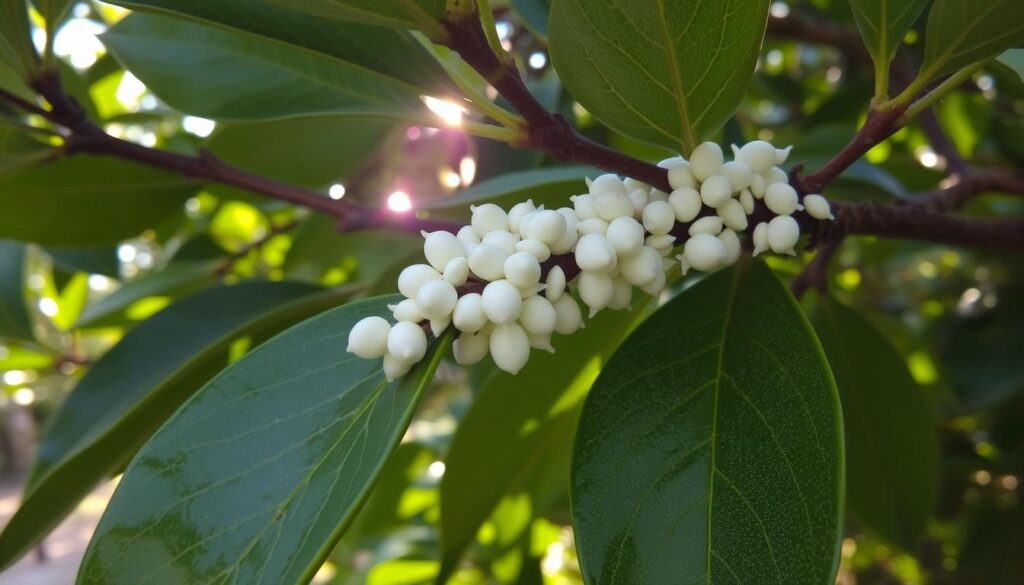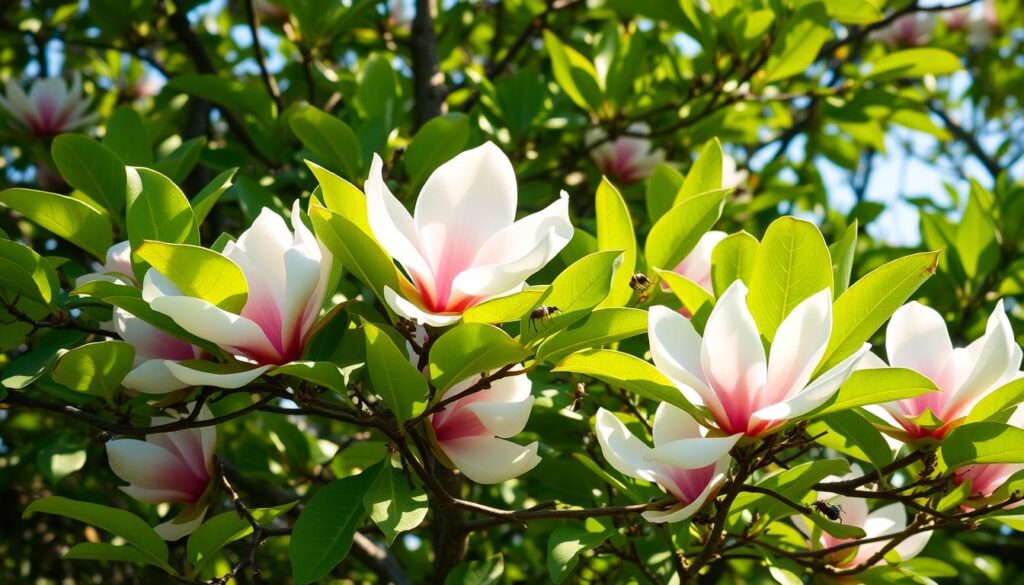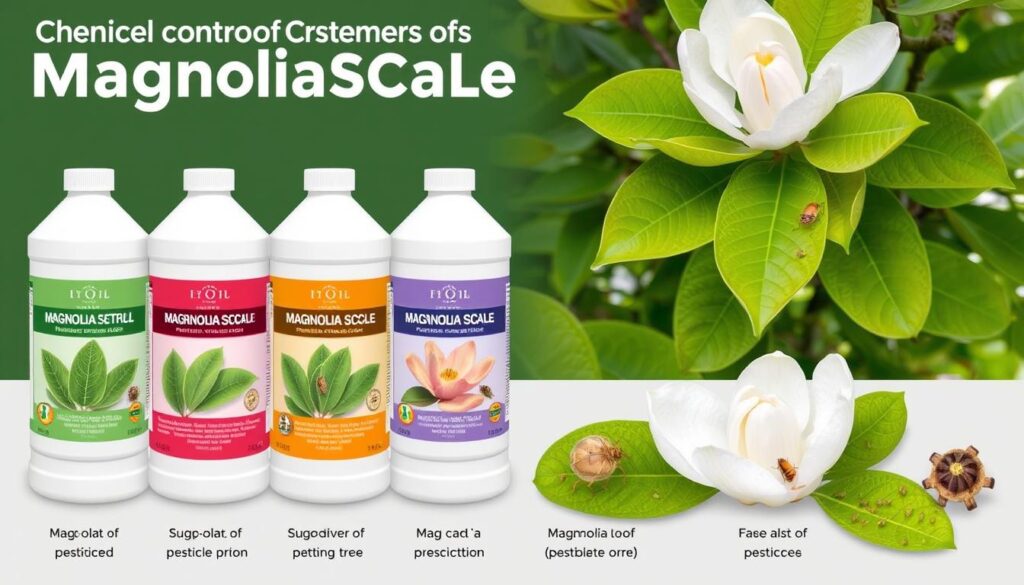Magnolia scale is a pest that harms magnolia trees by sucking their sap. This action deprives the trees of nutrients. Knowing how to treat magnolia scale is key to protecting these trees. Understanding its life cycle and symptoms helps gardeners and tree care experts take action.
Warm winters have led to more insect infestations, including magnolia scale. This is because cold weather is needed to keep pest populations down. In places like Massachusetts, Maine, and New Hampshire, treating magnolia scale is a big concern. By learning about magnolia scale, people can prevent infestations and protect their trees.
It’s important to recognize the signs of magnolia scale infestation early. Infected trees may excrete honeydew, attracting bees and wasps. This can lead to more pest problems. By knowing how to manage magnolia scale, people can protect their trees from harm.
Table of Contents
Key Takeaways
- Understanding the physical characteristics and life cycle of magnolia scale is essential for effective management.
- Regular inspections are critical for early detection and prevention of magnolia scale infestations.
- Effective magnolia scale treatment requires a holistic approach, including proper tree care and targeted control methods.
- Magnolia scale can reproduce and leave offspring, leading to increased infestations if not adequately treated.
- Learning how to treat magnolia scale is critical for preventing the spread of this pest and protecting tree health.
- Approximately 100% of magnolia species can be affected by magnolia scale, making it a significant concern for gardeners and tree care professionals.
Introduction to Magnolia Scale
Magnolia scale is a common pest that harms magnolia trees. It can cause problems for people and things nearby. Seeing white spots on magnolia tree means there might be an infestation. This can stress the tree, making leaves turn yellow and twigs die.
It’s important to know about magnolia scale. This includes who it attacks, where it’s found, and the damage it can do. Understanding this helps in managing the pest.
Experts say magnolia tree scale can be controlled with cultural and biological methods. But, these might not work for big infestations. Chemical treatments are best when the pests are young, in late summer to early fall.
So, the question will magnolia scale kill my tree depends on how bad the infestation is. Taking action quickly can help control the pest.
Some important facts about magnolia scale are:
- Magnolia scale is a soft scale insect, growing up to ½ inch long.
- Too many magnolia scales can stress trees, causing leaves to turn yellow and twigs to die.
- The honeydew from magnolia scale can cover plant surfaces, making it easy to spot before seeing the insects.
What is Magnolia Scale?
Magnolia scale is a soft-bodied insect that harms magnolia trees. Knowing its looks and life cycle helps control it. It has a shiny brown, elliptical shape and can grow up to 1/2 inch in diameter.
Physical Characteristics of Magnolia Scale
The magnolia scale is big, with a shiny brown color and an elliptical shape. Adult females can grow up to 1/2 inch in diameter. This makes them one of the largest soft scales.
Life Cycle of Magnolia Scale
The magnolia scale goes through several stages: crawler, nymph, and adult. The crawler stage is the most vulnerable. Watching for crawlers in late July through August helps control them.
Using imidacloprid or dinotefuran can control the pest. It’s also key to know if magnolia scale is harmful to humans. Handling infested plants safely is important. Choosing the right insecticide is also vital for effective control.
Understanding magnolia scale’s physical traits and life cycle helps gardeners manage infestations. This reduces damage to magnolia trees.
Identifying Magnolia Scale Infestations
To spot magnolia scale infestations, regularly check your trees, mainly in the growing season. Look for white, fluffy patches on branches and a sticky substance called honeydew. Black sooty mold on honeydew is a sign of a big scale problem.
When you inspect your trees, look under the branches for magnolia scale. Female scales are soft and can stain red when crushed. Finding the problem early is key, as severe cases can turn leaves yellow and kill branches, even the whole tree if not treated.
Some common signs of magnolia scale infestations include:
- White bumps on leaves, which turn brown and black as the problem grows
- Sooty mold on leaves, causing them to turn yellow and fall off
- Less flowers
Knowing how to get rid of magnolia scale is key to stopping scale magnolia tree diseases. Good magnolia tree scale treatment means taking care of your trees, checking them often, and using the right treatments. By acting early, you can save your magnolia trees from scale damage.
| Infestation Level | Symptoms | Treatment |
|---|---|---|
| Mild | White bumps on leaves | Regular inspections, pruning infested branches |
| Severe | Yellowing leaves, branch dieback | Systemic insecticides, neem oil, encouraging natural predators |
Environmental Conditions Favoring Magnolia Scale
Warm winters and high humidity help magnolia tree bugs, like the magnolia scale, grow. Knowing these conditions helps gardeners and tree care experts prevent infestations. Magnolia tree dripping sap is a sign of infestation, as scale insects eat the sap.
Several environmental factors favor magnolia scale growth and spread. These include:
- Warm temperatures
- High humidity
- Precipitation patterns
These conditions increase magnolia tree sap production. This attracts more scale insects. By understanding these factors, gardeners and tree care experts can protect their magnolia trees.

Impact of Magnolia Scale on Trees
Magnolia scale can harm magnolia trees a lot. It causes stress, damage, and can even kill the tree. Seeing black mold on magnolia tree might mean there’s an infestation of magnolia tree insects. If not treated, this can lead to white fungus on magnolia tree, making the tree weaker.
Some signs of stress in trees include:
- Yellowing leaves
- Premature defoliation
- A general decline in tree health
In bad cases, the infestation can kill branches or even the whole tree. It’s key to spot these signs early and act fast to stop the infestation.
Knowing how magnolia scale affects trees helps gardeners protect their magnolias. Regular checks and care can lessen the damage from magnolia scale. This keeps trees healthy and strong.
Natural Predators and Beneficial Insects
White spots on a magnolia tree’s branches might mean you have magnolia scale. Natural predators and beneficial insects can help control this pest. They keep the scale population in check, reducing the need for insecticidal soap.
Wondering why your magnolia tree is dripping sap? It might be stressed from scale infestation. Introducing lady beetles and lacewings can control scales and help your tree grow strong.
Importance of Predators in Control
Natural predators like parasitic wasps and lady beetles can manage magnolia scale. They eat the scale insects, cutting down their numbers and stopping infestations.
Common Beneficial Insects
Some beneficial insects for controlling magnolia scale include:
- Lady beetles
- Lacewings
- Parasitic wasps

By adding these beneficial insects to your garden, you create a balanced ecosystem. This promotes healthy tree growth and cuts down on chemical use.
| Beneficial Insect | Target Pest | Effectiveness |
|---|---|---|
| Lady beetles | Magnolia scale | High |
| Lacewings | Magnolia scale | Medium |
| Parasitic wasps | Magnolia scale | High |
Organic Control Methods for Magnolia Scale
For those who don’t like chemical pesticides, organic methods are a good choice. Insecticidal soap is a popular option. It works well when used with other methods.
Beneficial nematodes are another good choice. They can help control severe infestations. To get rid of scale on magnolia tree
Use of Insecticidal Soap
Insecticidal soap is gentle and safe. It breaks down the insect’s exoskeleton and dehydrates it. This kills the insect. To treat magnolia tree scale, apply it directly to the affected areas.
Introduction of Beneficial Nematodes
Beneficial nematodes are tiny worms that attack magnolia scale. They are natural and safe. Using imidacloprid for magnolia scale with them can be even more effective.
Chemical Control Options
Dealing with severe magnolia scale infestations might require chemical control. It’s key to know what to spray on magnolia scale to manage it well. Systemic insecticides, like imidacloprid, can be applied to the tree. These kill scale insects by being absorbed and spread throughout the plant.
For best results, apply these insecticides by drenching the root zone in early May. Horticultural oils are another option, effective if applied as dormant sprays in winter. But, always follow the label to avoid harming beneficial insects. White spots on magnolia branches can indicate an infestation, leading to white mold if not treated.
For more info on managing magnolia scale and pests, visit the Integrated Pest Management website. Chemical control should be a last resort to protect beneficial insects. By understanding and using these methods wisely, gardeners can manage magnolia scale infestations and protect their trees.

- Always follow the label instructions for any chemical control method.
- Apply systemic insecticides in early May for optimal results.
- Use horticultural oils as dormant sprays during winter to reduce overwintering scales.
- Avoid using chemical control methods as a first line of defense to minimize harm to beneficial insects.
By carefully considering these factors and using chemical control options judiciously, gardeners can effectively manage magnolia scale infestations and protect their trees.
Preventative Measures to Protect Your Magnolia Trees
Regularly checking and caring for your magnolia trees is key to avoiding magnolia scale problems. Make sure to water and fertilize them well. This keeps them strong against pests.
Look out for signs of scale, like bumps on leaves or yellow leaves. These are warning signs you need to act fast.
Here are some tips to keep your trees safe:
- Give them enough water, sunlight, and nutrients for growth.
- Trim off branches with lots of scales to stop them from spreading.
- Attract helpful bugs like ladybugs and lacewings to fight scales naturally.
Also, using magnolia scale systemic treatment can help prevent problems. Watch out for magnolia tree bugs and magnolia tree dripping sap. These can mean you have an infestation.
By taking these steps, you can keep your magnolia trees safe from scale infestations. This way, they’ll stay healthy and beautiful.
Managing Magnolia Scale Effectively
Managing magnolia scale well needs a mix of watching, controlling, and preventing. Knowing the pest’s life cycle and signs helps gardeners and tree care experts protect their magnolias. Regular checks, using horticultural oils and insecticidal soaps on time, and keeping trees healthy are key to fight off magnolia scale.
For bad infestations, systemic insecticides might be needed. But, it’s vital to talk to certified arborists to pick and use these treatments right. Working with tree care pros helps homeowners create a detailed plan for their magnolias. This plan keeps the trees strong and healthy for a long time.
Frequently Asked Questions
How do you treat scale on a magnolia tree?
To treat magnolia scale, start by pruning heavily infested branches. Then, wash the tree with a strong stream of water to remove soft-bodied scale insects. Apply horticultural oil in late winter to smother overwintering eggs. During the growing season, use insecticidal soap or neem oil to kill active crawlers. If the infestation is severe, systemic insecticides like imidacloprid can be applied to the soil to target the pests from within.
Will magnolia scale go away on its own?
No, magnolia scale won’t go away without intervention. If left untreated, the infestation will worsen, leading to weak growth, leaf drop, and sooty mold. Natural predators like ladybugs can help control scale, but most cases require direct treatment to prevent long-term damage.
What do you spray for scale on magnolias?
Use horticultural oil in late winter or early spring before new growth starts. During summer, insecticidal soap or neem oil can target the crawlers (young scale insects). For heavy infestations, a systemic insecticide like imidacloprid or dinotefuran can be applied to the soil to control the pests from within the tree.
Does magnolia scale spread to other plants?
Yes, magnolia scale can spread to other nearby magnolia trees and related species. The crawlers (young scale insects) can move to other plants, especially if trees are close together. Some types of scale may even infest different plant species, making it important to act quickly.
How do you get rid of scale fast?
For a fast solution, prune and dispose of heavily infested branches. Wash the remaining areas with a strong water spray to remove scale insects. Then, apply horticultural oil or neem oil to suffocate them. If the infestation is severe, use a systemic insecticide for long-term control. Regular monitoring is key to stopping reinfestation.
Will scale go away on its own?
No, scale infestations typically worsen over time if not treated. While natural predators like ladybugs can help reduce the population, most cases require direct treatment with pruning, horticultural oil, or insecticides to fully eliminate the problem.

